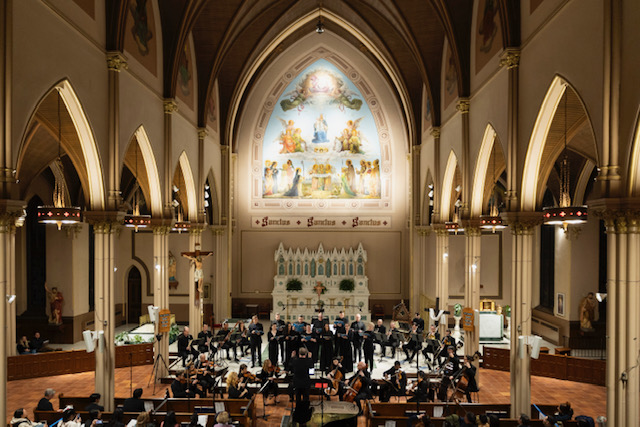Modus Operandi Orchestra (MOO) Modus@Mary Annual Spring Concert in Review
Modus Operandi Orchestra
Justin Bischof, conductor
Aydan Ferrao, piano
Modus Singers
St. Mary Church Long Island City, NY
April 27, 2024
On April 27, 2024, the Modus Operandi Orchestra (MOO) under the direction of Justin Bischof presented their annual spring Modus@Mary concert (Mary being the venue, the St. Mary Church in Long Island City). Pianist Aydan Ferrao was to make his MOO debut as soloist in Mozart’s Piano Concerto No. 12 in A major, K. 414, and the Modus Singers were to join MOO in a performance of Mozart’s Requiem, K. 626. The full hall (or more properly, church) was treated to an evening of masterpieces played by an outstanding ensemble.
Conductor Justin Bischof and fifteen-year-old Aydan Ferrao took the stage to open the concert with the first movement of Mozart’s Piano Concerto No, 12 in A major, K. 414. Usually a young artist is given this opportunity by virtue of a contest win, but this was not the case tonight. Maestro Bischof mentioned that he had heard Aydan practicing this work and was impressed enough to make a commitment to the young artist to have him play with MOO. That was not only a generous gesture, but an astute assessment of Mr. Ferrao’s talent.
Adyan Ferrao is a sophomore at Stuyvesant High School. He is a student of the excellent pianist Tatjana Rankovich. In addition to piano studies, he is active as a tenor soloist in the Oratorio choir, directs the A Cappella chorus, and is the chorus director for theatrical productions. As if that were not enough, he is an ice hockey player skilled enough to play on a traveling team.
One might expect a young man to want to “scale Mount Olympus” with a display of pyrotechnics, but Mr. Ferrao took a different path that showed musical maturity beyond his years. His shaping of phrases, his lightness of touch with fleet and even fingerwork, and his ensemble with the orchestra were all notable. This was real artistry! Not only this, but he evidently has iron nerves – the concert photographer actually passed by him and pointed a camera at him from the end of the open piano while he was playing! I could imagine any number of artists being undone by such a disruptive action, but this young man was completely unfazed. Maestro Bischof and MOO were ideal collaborators. The full hall gave Mr. Ferrao a standing ovation. The future should be bright for this young talent.
After a brief break, the stage was set for Mozart’s Requiem in D minor, K. 626. The Requiem has a storied history. Commissioned by Count Franz von Walsegg as a memorial to his late wife, it was unfinished by Mozart at the time of his death in 1791. His student Franz Xaver Süssmayr completed the work, using various sketches Mozart had left and his claim of being familiar with Mozart’s wishes about the composition. How much of the work is Mozart’s and how much is Süssmayr’s is still being debated to this day. Not surprisingly, the movie Amadeus came up in Maestro Bischof’s introductory talk. “How many of you saw that film?” he asked. He shook his head, sighed, and then said he spent ten years telling people “No, Salieri did not kill Mozart!” to the laughter of the audience.
This listener has heard many performances of the Requiem with all sorts of forces, from the gargantuan (several hundred singers and huge orchestra) to the skeletal (string quartet as “orchestra”). Tonight was, in my opinion, an ideal set of forces (twenty-seven orchestra players, twelve chorus members). Add to this, with the beautiful and acoustically live church venue, it was almost as if one had stepped back into the 19th century. There was an immediacy that was more impactful than much larger forces in a concert hall, and it was enthralling, not only to this listener, but to the audience as well who were transfixed for the entirety of the Requiem.
Maestro Bischof led with mastery. It was clear that he knew what he wanted, and his ensemble responded to his strong direction. The orchestra is chock full of superior musicians, and they demonstrated that in spades. The Modus Singers excelled as a chorus and as individual soloists. I’m going to name all twelve here. The sopranos were Halley Gilbert, Nola Richardson, and Amaranta Viera, and the altos were Alison Cheeseman, Heather Jones, and Guadalupe Peraza. The tenors were Marc Day, Alex Guerrero, and Lukas Papenfusscline, and the basses were Oliver Holt, Steve Hrycelak, and Thomas McCargar.
Highlights abound, but I wish to mention two in particular. Matt Melore, the trombone soloist in the Tuba mirum was outstanding, and the Confutatis had the snarling malevolence that I always hope for.
As the last notes of the Lux aeterna faded away, our souls were hanging in the balance waiting for final judgment, but the verdict of the audience was clear and decisive as they erupted into an immediate standing ovation. Congratulations to Maestro Bischof and MOO!

